What The Weights Machines In Your Gym Do
If you never take your strength training near your gym’s weights machines, here’s why you may want to think again
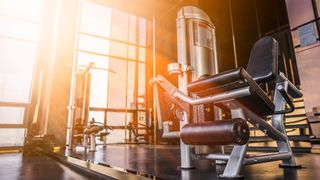
Since free weights work a wide range of muscle groups, plus your smaller stabiliser muscles, plus your core, all at the same time, why would you want to spend time with a weights machine that only lets you move along one path? Glad you asked.
For a start, it’s because that restricted range of movement allows beginners to learn good form, experienced lifters to stack more weight on and people returning from an injury to more safely reintroduce their bodies to the demands of lifting.
There is, of course, more to it than that, so we delved into it with the help of personal trainer Emily Servante, global trainer education manager at Ultimate Performance. We also enlisted Peter Williams from PureGym to guide us through the most common weights machines you’ll find in the gym – as well as some pointers that apply to every one. Still unsure of what to do? Our fool-proof gym machine workout plan for beginners may be of use.
What Are The Benefits Of Using Weights Machines?
“Because weights machines require less skill and motor control than free-weight exercises, they’re typically safer than free weights and cause fewer accidents and injuries,” says Servante.
Under the guidance of a PT they can also be used to get people working close to failure, which is a key component of building muscle, sooner than they would if they had to master the form of a free-weight exercise. “They are a highly effective tool to increase the client’s strength in key movement patterns in a short period,” says Servante. “This allows me to get my clients to a point where they can train close to failure and accumulate higher amounts of training volume, two key drivers of hypertrophy.
“It is often safer to train closer to failure on machine exercises, as it is far less likely for your technique to break down and cause you to fail. This is beneficial because your muscles are more likely to fail than your technique. This element is true for both beginner and advanced trainees.
“Some machine exercises also have better resistance profiles than free-weight exercises. A resistance profile essentially reflects which portion of a lift is most challenging and which is easiest, or in which portion you need to exert the most and least force.
“For example, during a dumbbell Romanian deadlift, the exercise is ‘harder’ at the bottom and ‘easier’ as you reach the top. This is important because some machines have resistance profiles that match where you’re physically stronger or weaker in a lift, which research shows can be beneficial for muscle growth and help develop all portions of a given muscle.
“Put simplistically, your muscles can produce less force when they’re ‘short’, such as at the top of a hip thrust when you clench your glutes, and your muscles can produce most force through their mid-range, such as when your forearms are parallel to the floor in a standing biceps curl.
“Some exercise machines reflect this with a bell-shaped resistance profile, where the resistance increases through the middle of the lift before starting to lower as you reach the top. These machines have been designed to target certain muscle groups in a way free weights cannot. You would struggle to replicate the resistance profile of a lying hamstring curl with dumbbells alone, for example.”
How To Use The Weights Machines You’ll Find In Most Gyms
One of the other advantages of weights machines is that there are instructions, which you should follow closely, including taking the time to adjust the seat, handles and anything else before adding weight – it’s only safer than free weights if you’re using it correctly.
Of course, it’s still possible to do yourself a mischief on a weights machine. You need to focus on form and keep your movements controlled throughout, and the best way to do that is to pick an appropriate weight.
“Most of the mistakes that are made on machines are because people are trying to lift heavy rather than just lifting in the correct pattern,” says Williams. Finding the right weight is trial and error, but you’re aiming for a weight that allows you to just complete the sets and reps in your plan before you fatigue. Keeping a diary of your training – detailing what you did, the weight you chose and how hard it was – can help you to home in on the right setting, but always start light. A light set or two can also help you fine-tune the settings and warm up the muscles that you’re about to focus on.
Once you’ve picked the right weight, make sure you’re controlling your movements, otherwise you’re wasting your time. “If you let the weight stack crash up and down, you’re not controlling the weight and not creating time under tension,” says Williams.
Get the Coach Newsletter
Sign up for workout ideas, training advice, reviews of the latest gear and more.
Here’s Williams’ run-down of the benefits of popular weights machines, and how they usually operate.
Chest press machine

Just like the bench press, a chest press machine works the obvious but also brings your triceps and shoulders into the equation. “If you are prone to shoulder injuries, it could be beneficial to use a chest press machine instead of doing a dumbbell or barbell bench press,” says Williams.
Ensure that the weight is set the same on both sides and, once you’re in the machine and gripping the handles, make sure your elbows aren’t behind your torso. If that’s the case you’re overextending and you need to make an adjustment.
Press the handles away from your chest until your arms are fully extended, then reverse the movement under control. “Rather than pushing the weight away from you and rounding your shoulders, you want to feel like you’re pushing your back into the seat while driving your hands out,” says Williams. “That will really put the focus on your chest.”
Pec deck or chest flye machine
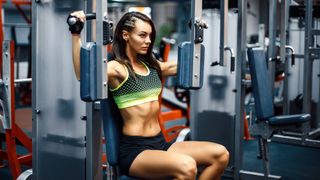
This contraption offers a more focused means of working your pecs, and again may be a better option than a chest flye with dumbbells for people with dodgy shoulders – but only if you get the movement right. “The big mistake I see is that people flare their elbows, because they’re trying to lift too much weight, ” says Williams. “This means they won’t actually get the contraction in their chest, which comes when your elbows cross the line of your shoulders.”
Sit with your back flat on the back rest, feet planted on the floor for stability and gripping the handles out to the sides, and bring your hands and elbows together. For greater muscle development, squeeze your pecs once your hands meet.
Lat pull-down machine
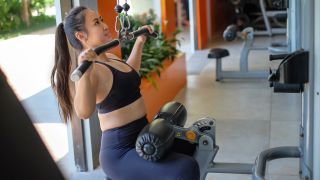
If a pull-up proves too difficult, turn to this machine. “If you can develop your strength in this movement plane it’s a stepping stone towards pull-ups,” says Williams.
Make sure the wide-grip handle is attached – a trainer at the gym can help if it’s not. Sit facing the machine with your back straight, legs tucked under the two circular support arms and feet firmly planted. “Make sure your arms are fully extended at the top,” says Williams. “Lean back slightly, bring the bar to your collarbone, squeeze your shoulder blades, then slowly release upwards.
“A common mistake with this machine is leaning back too far and using your bodyweight momentum to pull the weight towards the middle of your chest, rather than pulling it vertically down.”
Low-pulley cable bench
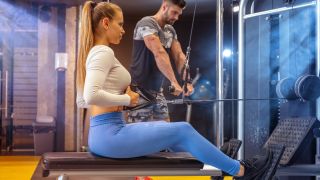
This cable machine is used to perform the seated row, a movement that primarily works your back but also delivers a biceps-building bonus. Controlling the weight is crucial on every machine, but it’s especially important here. “If people aren’t controlling the weight, as they bring their hands forwards they’ll round their shoulders and lose correct posture – and strength – when they’re trying to pull the weight,” says Williams.
Sit on the bench with your back straight and feet on the platform, and a slight bend in your legs. Grasp the rower handles with your arms extended and lift your chest to promote good posture. Pull the handles towards your stomach, keeping your elbows tucked in, until the handles reach your abs. Slowly lower the weights to the starting position.
“Focusing on pulling from your elbows will really help develop and strengthen your back,” says Williams. “Really squeeze your shoulder blades too – imagine there’s a tennis ball or a grape between your shoulder blades and you’re trying to squeeze it.”
Leg press machine

“The leg press is a good alternative to squats for someone with a back injury,” says Williams, and as with the squat, he recommends focusing on pushing through your heels.
Once you’ve selected your weight, sit in the machine and plant your feet flat on the platform and ready yourself to take the weight before you pull the release lever. Keep your hand near the lever so you can make the machine take the weight again at a moment’s notice. Bend slowly at the knee to lower the weight towards you, then push the weight back up. “Don’t lock your knees,” says Williams. “Not only do you lose the tension on your quads, which is very beneficial for gaining strength and muscle, you put a strain on your skeleton, which is just not wise.”
“A common mistake is not bringing the plate far enough back, which means you’re not getting the full range of motion and the full benefit of exercise,” Williams adds. “Make sure you form a 90° angle at the knee.”
Leg extension machine
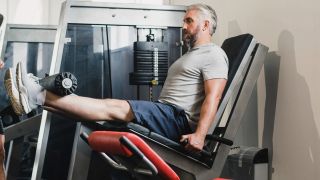
This machine allows you to isolate your quads, although other parts of your body – particularly your knees – may be at risk if you overdo the weight. “It’s more of an accessory movement to do at the end of your workout or even at the start as a warm-up,” says Williams, “but it’s a great way to target your quads.”
Sit in the machine with your shins pressing against the padded bar and your feet facing forwards. Pull the lever to engage the weight and, focusing on using your quads to power the movement, raise your lower legs until your legs are fully extended. Lower slowly under control. “A little tip for the leg extension is to point your toes like a ballerina,” says Williams.
Seated leg curl machine

Often found next to the leg extension machine, because it’s the opposite movement, this machine focuses on the other major thigh muscles – the hamstrings. Lie on the bench and make sure your calves are resting on the padded bar. Release the weight with the lever and bend at the knees to bring the padded bar towards the seat, then let the weight return to the start, keeping it under control.
Calf raise machine
The calves aren’t the easiest muscle to train in the gym: calf raises are the obvious go-to but once you’ve progressed enough to need to add weight to increase the challenge, you may find you’re hampered by your balance. Enter the calf raise machine, which allows you to do seated raises with added weight. Slide into the machine and adjust the pads resting on your quads so you feel secure. Your toes and the balls of your feet should rest on the platform with your heels pointing towards the ground. Press down through your toes to raise both heels, lifting the weight. Lower again so that your heels are pointing towards the ground.
“A big mistake is using it like a leg press and bending the knees,” says Williams. “Essentially the movement is a very small flex of your ankle, going from flat to tiptoes, pushing up as high as you can and squeezing your calf at the top. The most important thing is taking your time for each rep, and not bouncing up and down.”
Smith machine

This rack keeps a barbell on a fixed path and includes hooks on the supporting column so you can easily rack it at pretty much any point if you’re struggling.
To take control of the weight you’ll need to lift the barbell slightly, then rotate it so that it’s unhooked. Rotate in the opposite direction and lower into the hook.
“If you’re on your own and a bit nervous about using weights it can be a good way to develop movement planes without the risk,” says Williams. “It’s a good way to get very similar movement to the bench press and feel safe, but I wouldn't recommend it 100% for squatting because the bar path is not as natural as with free weights. There are ways to squat with it, where you kind of lean into it, but see a trainer in person before trying that! One thing it’s useful for if you’re struggling with your balance is a Bulgarian split squat, where you’ve got one foot on a bench.”
Functional trainer cable machine
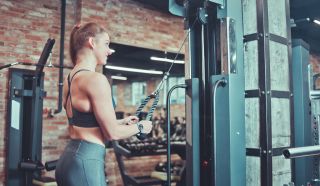
These intimidating-looking machines allow you to move the position of the pulley and are well worth getting to know because they’re so versatile. Set the pulleys high, for instance, and perform overhead triceps extensions, then set them to the low position for biceps curls. “There’s so much you could do on those I could talk for hours,” says Williams. “You’ll always see personal trainers hovering around them because they know that if the gym is busy but they can get to a functional trainer, you can get a good workout just using that bit of equipment.” Get started with our guide to the best cable machine exercises for all levels.

Jonathan Shannon has been the editor of the Coach website since 2016, developing a wide-ranging experience of health and fitness. Jonathan took up running while editing Coach and has run a sub-40min 10K and 1hr 28min half marathon. His next ambition is to complete a marathon. He’s an advocate of cycling to work and is Coach’s e-bike reviewer, and not just because he lives up a bit of a hill. He also reviews fitness trackers and other workout gear.
- Nick Harris-FrySenior writer
